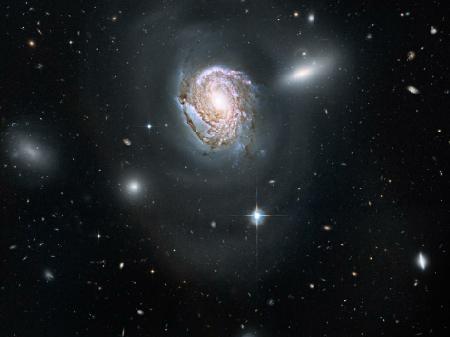
The galaxies in the Coma Cluster orbit much faster around each other than predicted, based on the matter we can see. The easiest way to account for this discrepancy is if there is invisible "dark matter".
Our theory of gravity[1] does an excellent job of explaining many things, from falling apples to the motion of the planets around the Sun. But physicists are not content until they've pushed a theory to the very limits: does it work at the level of galaxies or even clusters of galaxies?
Surprisingly, the answer is no. It turns out there is a lot about the gravity of large objects that we don't yet understand.
The first discrepancy came from observations of galaxy clusters.[2] A cluster is a group of galaxies which orbit each other, bound together by their mutual gravitational attraction. By measuring the brightness of each galaxy it is possible to estimate the number of stars it contains, and hence its mass. But the masses and orbital velocities of the galaxies made no sense: with such values the galaxies should have flown apart long ago.
The simplest way to make sense of the data is if there is matter in the galaxies that we cannot see. In the absence of any better ideas, this matter is called "dark matter". Dark matter has never been directly observed, but there is a lot of indirect evidence for it from the effect its gravity has on normal matter.
Our best theory of gravity is the general theory of relativity.
It's not clear that dark matter contradicts general relativity. It may be that we just need to include dark matter for it to work well. Some physicists have also theorised that general relativity itself needs to be revised and then the introduction of dark matter will be unnecessary.
A historical example of the former situation, where the theory is correct but there is missing matter, is provided by the discovery of Neptune. Uranus had already been discovered, but there were discrepancies between its observed orbit and the orbit predicted by Newton's law of gravity. These could neatly be explained if there was another planet further out that was influencing Uranus. In 1846 this planet was observed at exactly the place predicted by calculation.
An example of the latter situation, where discrepancies lead to an entirely new theory, is the explanation of the precession of the perihelion of Mercury. At the time one suggestion for fixing this observed violation of the laws of Newton was a new planet named "Vulcan". However this planet doesn't exist and in fact the precession can be explained with Einstein's general relativity, which superceded Newton's theory.
Dark matter was first postulated by Fritz Zwicky in 1934 to account for evidence of "missing mass" in the orbital velocities of galaxies in clusters.
Read more about Zwicky on Wikipedia or here.
Zwicky, F. (1933), "Die Rotverschiebung von extragalaktischen Nebeln", Helvetica Physica Acta 6: 110-127
Zwicky, F. (1937), "On the Masses of Nebulae and of Clusters of Nebulae", Astrophysical Journal 86: 217, doi:10.1086/143864
Author: Tom Brown
Copyright: public domain
Date last modified: 13th Oct 2011
Peer-review status: Not yet peer-reviewed
http://en.wikipedia.org/wiki/File:Coma_cluster.jpg public domain (from NASA)